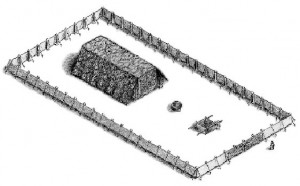 Every builder who contrives to construct an edifice first makes a plan to suit the requirements of that which suits the purpose for which he builds.
Every builder who contrives to construct an edifice first makes a plan to suit the requirements of that which suits the purpose for which he builds.
God, the greatest master builder of all, made three distinct plans or patterns of that which He builds in earth.
- Moses’ Tabernacle in the Wilderness: The First Temple – Exodus 25:1-9
- Solomon’s Temple in Jerusalem: The Second Temple – 1st Chronicles 22:9-11
- Jesus Christ the Man: The Beginning of the Third Temple – Matthew 24:2
Let us first look at the quality change in the materials which were used in both the building of Moses’ Tabernacle in the wilderness as against that used in the building of the Temple of Solomon.
In the Tabernacle of Moses, the materials were wood overlaid with gold, skins of animals, brass, threads of certain symbolic colors, and silver.
- Wood symbolically means carnal man.
- Gold symbolizes the Divine Nature.
- Skins of animals, which are produced by the will of the flesh, symbolize sacrifice and covering. This, more than anything else, brings us into the realm of a life of intercession for others and an unselfish surrender for the good of the Body of Christ.
- Brass symbolizes judgment and justice against sin.
- Colors: Blue means purification.
White linen means purity.
Red signifies the blood of Jesus.
Purple stands for kingship.
There were some marked differences between Solomon’s Temple and the Tabernacle of Moses in the type of materials used in construction. Skins of animals, which represent the will of flesh, and wood, which represents humanity, though covered with gold (divinity) were used in Moses’ tabernacle. In Solomon’s temple, stones were used for the walls, which, unlike skins, were not produced by the will of the flesh, but by process of God’s own operation. The individual stones were inlaid with golden mortar poured into a pattern of holes drilled into them (more like our cement blocks) and plastered on the outside with pure gold, thus covering the nakedness of their presence in the temple by His own divinity, and at the same time filling them inside also with divine life. God’s promise to man is that He would walk in them and talk in them.
2nd Corinthians 6:16, “And what agreement hath the temple of God with idols? For ye are the temple of the living God; as God hath said, I will dwell in them, and walk in them; and I will be their God and they shall be my people.”
The work was no more to be just an outward covering up of the nature of man under the nature of God, but even as the GOLDEN MORTAR permeated the inside of the stones, so The Living God would work on the inside of man.
All brass objects were peculiar to the Outer Court, for the Outer Court is the place where God deals with sin.
In Solomon’s temple, the size and number of the symbolic furniture were increased. For instance, the candlesticks (lampstands) were multiplied to TEN, which speaks of the massive increase in the “dunamin” power of the Holy Ghost’s work in the soul and spirit realm of the individual believer, and the church generally (2nd Chronicles 4:7). The candlesticks were placed, five on the right side and five on the left. The Table of Shewbread was also multiplied to ten. Five tables were on one side and five on the other. Five is the number of the Ministry.
This placing of the ministry – five on the right and five on the left – signifies that there would be a ministry that was carnal and would be like the foolish virgins, and there was a ministry that would be wise and be as the wise virgins.
The cherubim were also greatly multiplied in size. The cherubim on the Mercy Seat were apparently small figures, maybe no bigger than 1 cubit or 18 inches, but the cherubim in Solomon’s temple touched from one wall of the temple to the other. They were twenty cubits in their wing span. Wing touched wing and the outer wings touched the walls. This speaks of the increase in the overwhelming abundance of the overshadowing at the Mercy Seat. This means that when the spirit of man is incorporated with the Spirit of God, the soul is overshadowed. Between the soul and the spirit is the place where we meet face to face with God.
| << Previous Page | Next Page >> |